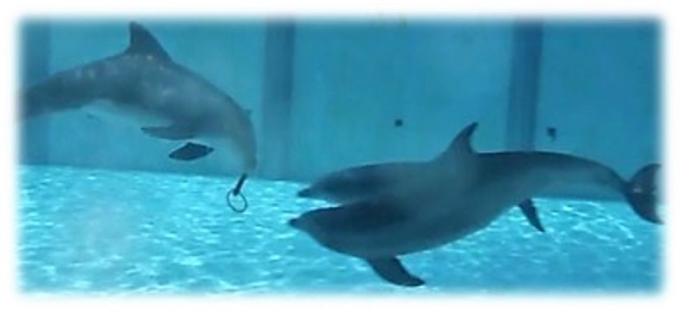Material and Method
The enrichment used for this study consisted of 20, partly submerged “fish hides”. They were flexible, plastic tubes vertically floating below the surface. Treats, such as fish or other food items could be hidden within each tube. The content would them be held below surface level, enabling dolphins to use echolocation to distinguish between filled or unfilled fish hides. The feed was partly considered to be a positive reinforcement for interacting with fish hides correctly, but also functioned as the tool used to increase difficult level in the interaction task ahead.
The “problem” in question, would be to free content by pulling fish hides though the water, after choosing which one of the 20 fish hides to interact with. The number of fish hides would further influence the difficulty level and flexibility in task formation.

Dolphins
The data collection was conducted at the dolphinarium of Kolmården Wildlife Park, Sweden, from August to December 2017. The dolphinarium hosted a pod of eight Atlantic bottlenose dolphins (Tursiops truncatus), all of which participated in the study. Ages ranged from 2 to 34 years.
Caretakers regularly trained their dolphins to split into two smaller groups as part of the daily handling. Divisions into smaller groups created opportunities to train behaviours which were a part of the public presentation, as well as behaviours needed for health monitoring. As the animals were considered to behave with little if any difference at all when divided, groups of four were used throughout the study.
Setup for enrichment interactions
Dolphins were allowed into the medical pool to interact with fish hides for 20-minute sessions. Two sessions were made each day from Monday to Friday, so that all dolphins had a chance to interact each day for five weeks with differences in the task setup presented every week. During the first five days, dolphins would find that 100% of the fish hides contained fish. The reason was to enable them to associate the enrichment with a treat and learn that there was something to gain from interactions. Week two gave dolphins a 75% chance to find fish. Week three had 50% and week four 25%.
A fifth "phase" with 25% fish was added, to optimise the chance to use echolocation. During the fifth phase, herring was put into the fish hides, while previous weeks had been made with capelin. Capelin have a lower Target Strength and thus produces a much smaller echo. The reason why capelin was used was the risk of overfeeding animals, and compromises were made which later were suggested to have been problematic for the dolphins’ ability to learn.

Data collection
Data was collected by filming sessions both from above and below surface. The fish hides could then be identified as full, previously full or empty and each animal could be followed to sample behaviours continuously throughout sessions. From above, focus was mainly on swim pattern, but also function as a second dimension to which certain behaviours could be studied more easily. Each dolphin was identified and followed during data collection, and behaviours were sampled by continuous methods.
Responsible for this page:
Director of undergraduate studies Biology
Last updated:
05/29/18
